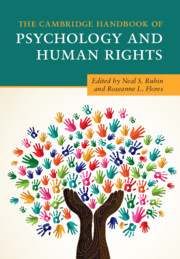Book contents
- The Cambridge Handbook of Psychology and Human Rights
- The Cambridge Handbook of Psychology and Human Rights
- Copyright page
- Dedication
- Contents
- Figures
- Tables
- Boxes
- Contributors
- Acknowledgments
- The Core International Human Rights Instruments and Their Monitoring Bodies
- Universal Human Rights Instruments
- Sustainable Development Goals
- Glossary of United Nations and Psychology Acronyms in the Handbook
- Introduction
- Part I History of Human Rights
- Part II The Intersection of Psychology and Human Rights
- 5 The Intersection of Psychology and Human Rights in Addressing Racism, Discrimination, and Xenophobia
- 6 Poverty and the Human Rights of Children and Youth through the Lenses of Psychology and Sociology
- 7 Labor Rights as Human Rights
- 8 Whose Culture? Challenging the Idea of an Opposition between Women’s Human Rights and the Right to Culture
- 9 Human Rights
- 10 Child Rights
- 11 Human Rights of Persons with Disabilities
- Part III Contemporary Issues in Psychology and Human Rights
- Part IV Teaching, Research, and Training in Psychology and Human Rights
- Part V Future Directions
- Index
- References
10 - Child Rights
Why They Matter and How to Realize Them
from Part II - The Intersection of Psychology and Human Rights
Published online by Cambridge University Press: 02 October 2020
- The Cambridge Handbook of Psychology and Human Rights
- The Cambridge Handbook of Psychology and Human Rights
- Copyright page
- Dedication
- Contents
- Figures
- Tables
- Boxes
- Contributors
- Acknowledgments
- The Core International Human Rights Instruments and Their Monitoring Bodies
- Universal Human Rights Instruments
- Sustainable Development Goals
- Glossary of United Nations and Psychology Acronyms in the Handbook
- Introduction
- Part I History of Human Rights
- Part II The Intersection of Psychology and Human Rights
- 5 The Intersection of Psychology and Human Rights in Addressing Racism, Discrimination, and Xenophobia
- 6 Poverty and the Human Rights of Children and Youth through the Lenses of Psychology and Sociology
- 7 Labor Rights as Human Rights
- 8 Whose Culture? Challenging the Idea of an Opposition between Women’s Human Rights and the Right to Culture
- 9 Human Rights
- 10 Child Rights
- 11 Human Rights of Persons with Disabilities
- Part III Contemporary Issues in Psychology and Human Rights
- Part IV Teaching, Research, and Training in Psychology and Human Rights
- Part V Future Directions
- Index
- References
Summary
The UN Convention on the Rights of the Child guarantees comprehensive rights to all children (people under 18 years of age). These entitlements, which states cannot take away, are essential for children’s protection, healthy development, participation, and agency, and they also provide a moral compass for working with children. Because child rights often exist more on paper than in reality, it is important to develop strategies for realizing children’s rights. With an emphasis on settings of armed conflict, useful strategies include learning from children’s lived experiences, enabling children’s agency and decision-making power, education about child rights in a way that fits the local context, social mobilization and empowerment, social norms changing harmful practices, international influencing and enforcement of international law, and reporting of violations and whistleblowing, among others. Child rights and psychology have interrelated agendas, since both seek to promote human well-being, including children’s well-being. The chapter concludes that psychologists will achieve their mission of enabling human well-being only if they make child rights central in their own work.
Keywords
- Type
- Chapter
- Information
- The Cambridge Handbook of Psychology and Human Rights , pp. 150 - 163Publisher: Cambridge University PressPrint publication year: 2020
References
- 1
- Cited by



